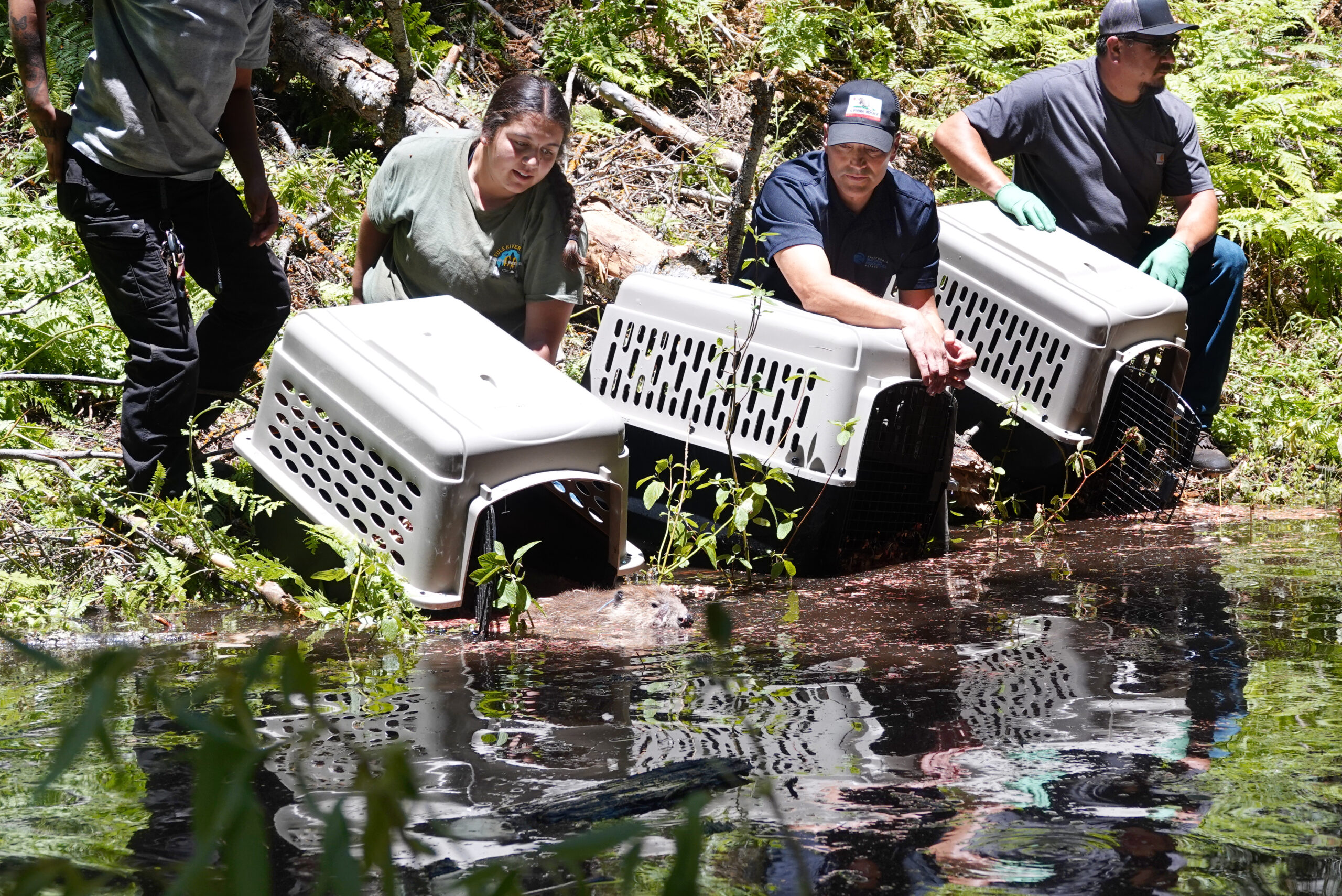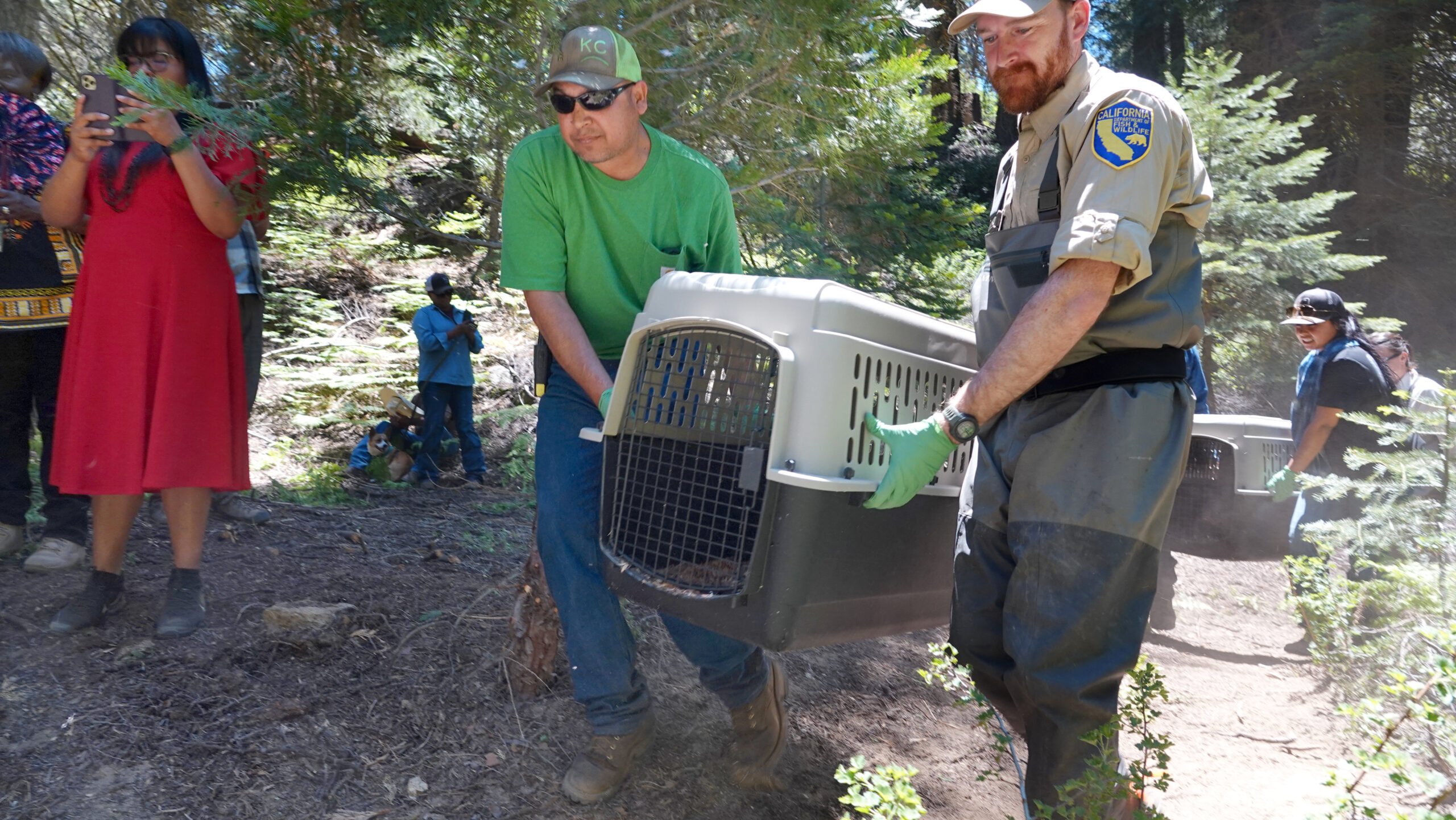What do you know, It’s time for another beaver release on tribal lands. Yesterday beavers were returned to the Tule River near Upland from Fresno. They trap a bundle of beavers in the vicinity so I’m sure they had their pick of candidates. Three adults, one yearling and three kits were released back to the Tule tribe who have been asking for beavers for literally ever or at least as long the San Pedro has been trapped out.
Beavers are Back on Tule River Tribe Lands in the Southern Sierra Nevada
After years of work by the Tule River Tribe, a family of seven beavers has been released into the South Fork Tule River watershed on the Tule River Indian Reservation as part of a multi-year beaver reintroduction effort done in partnership with the California Department of Fish and Wildlife (CDFW).
Beavers play a critical role in the ecology and stewardship of the land. They build dams that retain water on the landscape, extending seasonal flows, increasing summer baseflows, improving drought and wildfire resilience and better conserving the Tribe’s drinking water supply, of which about 80% comes from the Tule River watershed.
CDFW wildlife biologists also expect to eventually see better habitat conditions for a number of endangered amphibian and riparian-obligate bird species, including foothill and southern mountain yellow-legged frogs, western pond turtle, least Bell’s vireo and southwestern willow flycatcher.
Gee do ya think? It’s hard to be cynical about anything in this release because I remember getting emails from McDarment asking for beavers since we first published our papers.
 “We’ve been through numerous droughts over the years. Going through these droughts we were wondering how we can conserve, save water, get water here on our lands,” said Kenneth McDarment, a Tule River Tribe member and past tribal councilman. “The answer was in our pictographs.”
“We’ve been through numerous droughts over the years. Going through these droughts we were wondering how we can conserve, save water, get water here on our lands,” said Kenneth McDarment, a Tule River Tribe member and past tribal councilman. “The answer was in our pictographs.”
Estimated to be between 500 and 1,000 years old, beaver pictographs can be seen at Painted Rock next to the South Fork Tule River on the 55,356-acre reservation. Tribal elders recall beavers being present in the high elevation meadows when they were young, but prior to this release, beavers have not been present on the reservation for decades.
“We can make our future different from our past,” said CDFW Director Charlton H. Bonham. “Our past is one where we treated these animals and others as varmints, as nuisances, and our culture over time ran them off the landscape. That can’t be our future.”
Well technically we treated these animals as hats. We didn’t get the idea they were vermin until YOU told us they were in the 1950s. But I guess that’s blood under the bridge now.
Ten years ago, tribal leaders set a course to bring beavers back to the Tule River watershed, and through research, advocacy, and the state’s pursuit of nature-based solutions, CDFW received state funding to launch its Beaver Restoration Program in 2022. The program created a pathway for the Tribe to reintroduce beavers into their river waters, supporting efforts to ready sites to receive the beavers.
The program partners with tribes, non-governmental organizations, private landowners and other state, federal and local agencies to implement beaver restoration projects.
Before the beavers’ arrival, Tule River Tribe spiritual leader JR Manuel performed a blessing and was joined by Anthony Hunter of the Tachi Yokut Tribe and Elder Robert Gomez, chairman of the Tubatulabal Tribe.
“I’m very happy to see (the beavers) come home and it’s going to be wonderful to watch them do their thing,” said McDarment. “People will be educated even more by seeing the work that they do and the benefits they bring to the environment. My hope is to have the beaver throughout the reservation and all the watershed that we have.”
The initial June 12 release included three adult beavers, one subadult and three babies, or “kits.” Two additional beavers were released into Miner Creek on the Tule River Reservation June 17 and more will be reintroduced in coming months and years to reestablish a genetically diverse population in the watershed.
If they don’t get eaten first. Here’s hoping.
CDFW wildlife biologists remained on site in the days following the release to monitor the beavers’ behavior. According to the latest report from the field team, the family group has remained together at the release site on Eagle Creek.
Organizations also supporting the Tule River Tribe in its beaver restoration efforts include the U.S. Fish and Wildlife Service, the Tulalip Tribes Beaver Project, U.S. Forest Service (Sequioa National Forest and South Pacific Research Station), the Occidental Arts and Ecology Center, Swift Water Design and Acorn Environmental.
I guess that explains why none of them can attend the beaver festival this year. I’m happy the Tule tribe finally gets their beavers.
This video is from their media packet. It was too big to upload to our website and they hadn’t put it on their channel yet so I am temporarily putting it on ours. Enjoy these clips. There are long pauses between them but they are fun to watch,







































